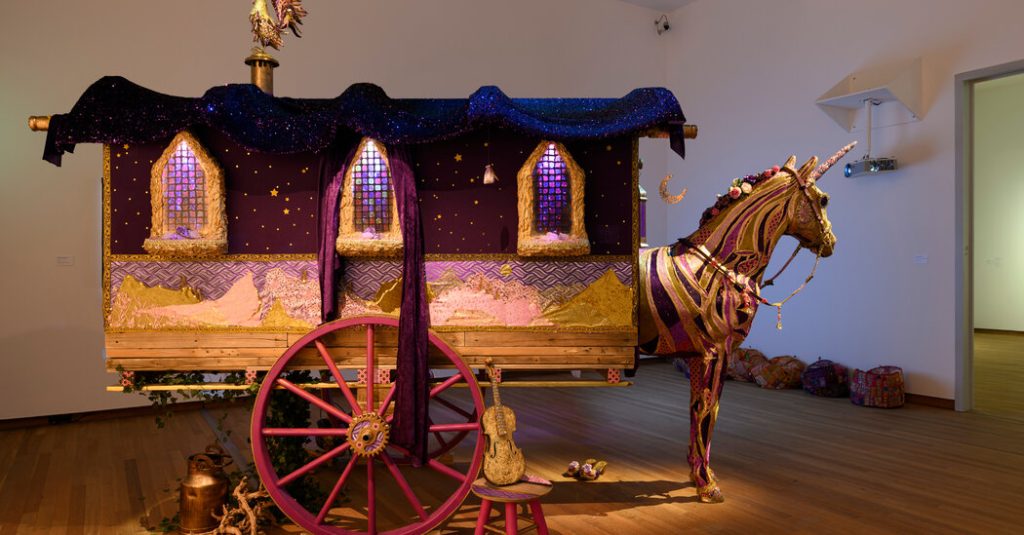The Visionary Art of Morena Bamberger
In a vibrant and imaginative art installation titled Sonnekaskro Djiephen (“a life of gold”), Sinti artist Morena Bamberger envisions a utopian world where her people, once nomadic, can still travel freely on wooden wheels. Her work, featured in the “Dream On” exhibition at the Bonnefanten museum in Maastricht, depicts a two-legged unicorn pulling a wooden chariot adorned in purple velvet. Nearby, a bejeweled gold dog dressed in a purple and pink jacket plays beside a laundry line, where a film is projected onto a drying sheet. This whimsical scene symbolizes a world where the Sinti and Roma communities can roam without restriction, a stark contrast to the current legal barriers imposed by European laws.
Bamberger, who grew up in a tight-knit Sinti community in Herkenbosch, the Netherlands, draws inspiration from her roots. Her community, though small, was deeply connected, with open doors and shared life. Her art reflects a longing for freedom and a connection to her heritage, imagining a future where her people can reclaim their nomadic traditions.
The Curators’ Vision: A New Wave of Utopian Art
The “Dream On” exhibition, co-curated by Roxy Jongewaard and Celien Govaerts, explores a recent trend in contemporary art where artists envision a better world. Over 60 artworks are on display, created by both emerging and world-renowned artists such as Grayson Perry, Laure Prouvost, and Otobong Nkanga. The exhibition shifts away from institutional critique and instead embraces hopeful and imaginative visions of the future.
Jongewaard explains that these artists often use fairy tales, myths, folklore, and songs to explore their utopian ideas. These narratives, deeply rooted in collective identity, are reimagined to create fresh perspectives on the world. The exhibition’s title, “Dream On,” is a playful reinterpretation of a common phrase often used to dismiss big dreams. The curators aim to reclaim this phrase as a call to imagine a better future, emphasizing the power of art to inspire change.
Artists Envisioning a Better World
The exhibition features a diverse range of artists, from 98-year-old Betye Saar, a Los Angeles-based artist, to 24-year-old Sofiia Dubyna, who fled her hometown of Donetsk, Ukraine, before it was seized by Russia. Their works, though varied, share a common thread: the exploration of utopian ideals through fantastical imagery.
For instance, Alia Farid’s 2019 video work, “At the Time of the Ebb,” captures an annual ritual on Qeshm Island, where participants dressed as camels, horses, and birds dance by the sea to celebrate the fishing season. This ritual, adapted over time, reflects a longing to preserve tradition while embracing change. Similarly, Roma artist Malgorzata Mirga-Tas’s intricate textile works, including a portrait of activist Lalla Weiss, celebrate resilience and activism through vibrant colors and symbolic imagery.
Themes and Motifs: Fantasy and Social Change
Mythical creatures and monsters are central to many works in the exhibition, but they are not just decorative. These elements serve as metaphors for pressing issues like decolonization, climate change, and feminism. While the imagery is often fantastical, the themes are deeply rooted in real-world challenges.
Jongewaard notes that artists are shifting away from “doom-mongering” and instead infusing their work with joy and empathy. This approach creates a sense of hope and connection in a polarized world. By imagining a better future, these artists invite viewers to reflect on their own lives and the world around them.
The Role of Cultural Heritage in Shaping Utopian Visions
For Bamberger, art is a way to reconnect with a deeper sense of purpose and vitality. She uses fairy-tale metaphors to describe her vision of a world where people are no longer confined by modern constraints. “We were once wolves living in a pack in the forest, howling free,” she says, symbolizing a loss of autonomy in contemporary life. Her art challenges viewers to look beyond the illusions of modern society and reconnect with their true selves.
Similarly, the exhibition as a whole highlights the importance of cultural heritage in shaping these utopian visions. By drawing on tradition, folklore, and mythology, artists create a bridge between the past and the future, imagining a world that is both familiar and transformative.
Conclusion: The Power of Utopian Art
The “Dream On” exhibition is more than just a collection of artworks; it is a call to action. By envisioning a better world, these artists inspire viewers to think critically about the present and imagine a future filled with hope and possibility. Whether through mythical creatures, vibrant textiles, or celebratory rituals, the works on display remind us that art has the power to provoke, inspire, and transform.
In a world grappling with polarization and uncertainty, the exhibition offers a much-needed injection of optimism. It shows that even in dark times, the act of dreaming can be a powerful form of resistance and a reminder of the boundless potential of the human imagination.


